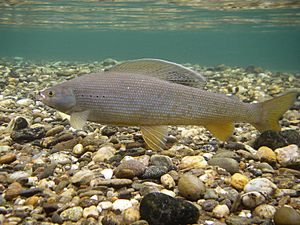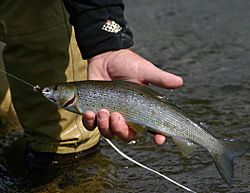Arctic grayling facts for kids
Quick facts for kids Arctic grayling |
|
|---|---|
 |
|
 |
|
| Conservation status | |
| Scientific classification | |
| Synonyms | |
|
previous scientific names
Salmo arcticus (Pallas, 1776)
Thymallus arcticus arcticus (Pallas, 1776) Coregonus signifer (Richardson, 1823) Salmo signifer (Richardson, 1823) Thymallus signifer (Richardson, 1823) Coregonus thymalloides (Richardson, 1823) Salmo thymalloides (Richardson, 1823) Thymalus ontariensis (Valenciennes, 1848) Thymallus tricolor (Cope, 1865) Thymallus signifer tricolor (Cope, 1865) Thymallus montanus (Milner, 1874) Thymallus tricolor montanus (Milner, 1874) Thymallus arcticus lenensis (Weiss, Knizhin, Kirillov & Froufe, 2006) |
The Arctic grayling (Thymallus arcticus) is a cool freshwater fish. It belongs to the salmon family, called Salmonidae. You can find these fish across the Arctic and Pacific regions. They live in places like Canada, Alaska, and Siberia. You can also find them in the upper Missouri River in Montana. Some populations have been introduced to lakes in Arizona and the Rocky Mountains.
Contents
Meet the Arctic Grayling: What Makes It Special?
The Arctic grayling has a scientific name: Thymallus arcticus. A German scientist named Peter Simon Pallas gave it this name in 1776. He studied fish from Russia. The first part of its name, Thymallus, comes from a faint smell. This smell is like the herb thyme and comes from the fish's flesh.
How Big Do Arctic Grayling Get?

Arctic grayling can grow quite large. The longest one ever recorded was about 76 cm (30 in) long. The heaviest one weighed around 3.8 kg (8.4 lb). They look a lot like the European grayling. However, Arctic grayling do not have spines in their back or bottom fins. They also have more soft rays in these fins.
Colors and Markings
These fish have a dark stripe along their sides. This stripe runs between their front and back fins. Their sides might also have a pretty pink, shiny color. Some Arctic grayling have been known to live for up to 18 years!
Where Do Arctic Grayling Live?
Arctic grayling are found in many cold places. They live in rivers that flow into the Arctic Ocean. This includes areas from Hudson Bay in Canada all the way to Alaska. They also live in parts of central Alberta and British Columbia. You won't find them naturally in the Fraser River or Columbia River basins.
Native and Introduced Homes
There are still some native groups of grayling in the upper Missouri River in Montana. These are sometimes called "Montana Arctic grayling". They used to live in the Great Lakes area in Michigan. In Siberia, they live in rivers like the Ob and Yenisei. They are also in some rivers in European Russia. People have also put Arctic grayling into lakes in the Rocky Mountains. This includes lakes in Wyoming, Utah, Oregon, California, and even as far south as Arizona.
Arctic Grayling Life Cycle
Arctic grayling have different ways of living. Some live and lay eggs in rivers. These are called fluvial populations. Others live and lay eggs in lakes. These are called lacustrine populations. Some live in lakes but swim to streams to lay eggs. These are called potamodromous populations.
What Do They Eat?
Arctic grayling prefer cold water. They live in medium to large rivers and lakes. They return to rocky streams to breed. These fish eat many different things. Their main foods are small crustaceans, insects, and insect larvae. They also eat fish eggs. Larger grayling eat other fish. Young grayling eat tiny water animals called zooplankton and insect larvae.
How Do Arctic Grayling Reproduce?

Spawning, or laying eggs, happens in the spring. Adult fish look for shallow river areas. These spots have fine sand and a steady current. Male grayling claim a territory. They try to attract females by showing off their colorful back fins. They also use these fins to hold the female during mating. The eggs are released and mix with the sand.
The eggs are small, about 3 mm or 0.1 in across. The baby fish hatch after two to three weeks. They stay hidden in the sand until they have used up all their food from the yolk. They come out when they are about 12 to 18 mm (0.5 to 0.7 in) long. At this size, they form groups called shoals along the river edges. Young grayling grow very quickly during their first two years.
Protecting Arctic Grayling
Arctic grayling are generally considered a safe species. This means they are not in danger of disappearing. Some groups in the southern parts of their native range have disappeared. However, they are still common in many other places. They are not on the IUCN Red List of threatened species.
Conservation Efforts
The grayling population in the upper Missouri River basin in Montana was once a big concern. This unique group was almost gone from all areas except the Big Hole River. The US Fish & Wildlife Service (FWS) started a plan to help them. This plan was called a "Candidate Conservation Agreement with Assurances" (CCAA). This agreement helped landowners protect the fish. In return, they would not face legal issues under the Endangered Species Act. In 2014, the FWS decided not to list the grayling as endangered. This was because the CCAA plan was working well.
Importance to People
Arctic grayling are important for several reasons. They are a "key subsistence species" for the Iñupiat people of Alaska North Slope. This means they are an important food source. They are also raised on farms for food. Plus, they are a very popular fish for sport fishing in Alaska.
See also
 In Spanish: Thymallus arcticus para niños
In Spanish: Thymallus arcticus para niños



